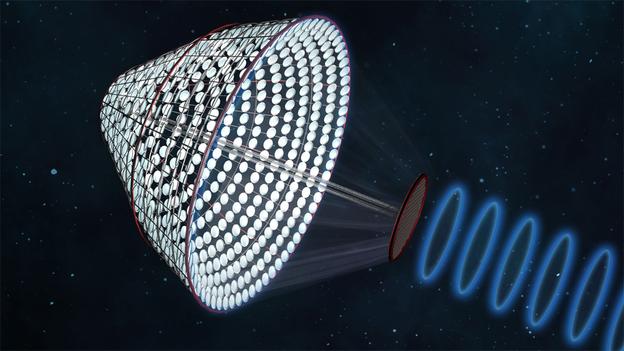- Web
- Humsa
- Videos
- Forum
- Q2A



It would solve our energy needs overnight. But with huge technological and financial challenges, can space-based solar power ever take off?
“Ex-Nasa scientist seeks visionary billionaire to help change the world. High risk venture. Return not guaranteed. GSOH a plus.”
John Mankins, the scientist in question, has not yet reached the point of placing a classified ad, but it could soon be an option. The 25-year veteran of the US space agency is the man behind a project called SPS-Alpha, which aims to loft tens of thousands of lightweight, inflatable modules into space. Once there, they will be assembled into a huge bell-shaped structure that will use mirrors to concentrate energy from the sun onto solar panels. The collected energy would then be beamed down to ground stations on Earth using microwaves, providing unlimited, clean energy and overnight reducing our reliance on polluting fossil fuels. The snag? It is unproven technology and he estimates it will take at least $15bn- $20bn to get his project off the ground.
Mankins initially had research funding from an advanced concepts arm at Nasa, but that money dried up in September 2012; hence his continuing search for a benefactor.I can't think of a better solution than to find somebody who is very wealthy, very visionary and willing to make this happen,” he saysBut not everyone shares Mankins' optimism. Space-based solar power (SBSP) is a topic that divides the scientific world into extremes. On one side are people like Mankins who believe it is the only solution to our ever increasing energy demands, whilst on the other is a sizeable chunk of the scientific community who believe any money put into solar power should remain firmly on the ground.
High times
SBSP has its roots in the 1941 short story Reason, by Isaac Asimov, which depicts a space station – run by robots – collecting energy from the sun to distribute to Earth and other planets. No further thought was given to the idea until the late 1960s, when aerospace engineer Peter Glaser began to investigate its potential. In the following decades, various concepts were put forward but none took off. At the same time Nasa and the US Department of Energy also became involved, funding bits and pieces of research and commissioning reports into its feasibility. Most of these concluded that SBSP was too “high risk” and too costly.
But in recent years, SBSP has once again begun to attract attention with projects emerging in the US, Russia, China, India and Japan, amongst others. All are driven by increasing energy demands, soaring oil and gas prices, a desire to find clean alternatives to fossil fuels and by a burgeoning commercial space industry that promises to lower the cost of entry into space and spur on a host of new industries.
“SBSP is the ultimate energy source for the world and eventually it's going to replace nearly everything else,” says Ralph Nansen of US-based advocacy group Solar High, with some of the characteristic hyperbole that defines both sides of the SBSP debate. “I don't think there's any doubt that within the next century we will be getting the majority of our power from space. It's just a question of when.”Nansen is calling for the US government to invest in SBSP research and development as a matter of urgency.
“England dominated the world economy during the industrial revolution because of coal. The United States dominated the world economy after the discovery of oil in Brownsville, Texas in 1901. I'm confident that whoever develops SBSP will have a similarly dominant position in the world economy,” he says.
Nansen, like other SBSP advocates, contends that instead of building huge solar farms on the surface of the Earth, which are at the mercy of fluctuating weather conditions and the cycle of day and night, mankind should fly a little closer to the sun. Specifically, they advocate building solar farms in geostationary orbit 35,800km (22,000 miles) above the Earth's surface. There, sunlight has an intensity of 1,347 Watts per metre squared - about 30% more intense than on the Earth's surface, meaning greater electricity production. And depending on its orbital position, an SBSP system could harness direct sunlight almost the entire year round, unlike terrestrial solar farms.
 The US intelligence community has concluded that America is the target of a massive cyber-espionage campaign that is threatening its competitiveness, The Washington Post reported late Sunday.
Citing unnamed officials, the newspaper said the conclusion is contained in the National Intelligence Estimate, a classified report that represents the consensus v..... Read more
The US intelligence community has concluded that America is the target of a massive cyber-espionage campaign that is threatening its competitiveness, The Washington Post reported late Sunday.
Citing unnamed officials, the newspaper said the conclusion is contained in the National Intelligence Estimate, a classified report that represents the consensus v..... Read more
 A hypersonic "SpaceLiner" would whisk up to 50 passengers from Europe to Australia in 90 minutes. The futuristic vehicle would do so by riding a rocket into Earth's upper atmosphere, reaching 24 times the speed of sound before gliding in for a landing.Many challenges still remain, including finding the right shape for the vehicle, said Martin Sippe..... Read more
A hypersonic "SpaceLiner" would whisk up to 50 passengers from Europe to Australia in 90 minutes. The futuristic vehicle would do so by riding a rocket into Earth's upper atmosphere, reaching 24 times the speed of sound before gliding in for a landing.Many challenges still remain, including finding the right shape for the vehicle, said Martin Sippe..... Read more
 A `Google generation` which relies on the Internet for everything is in danger of becoming `brain-dead`, a leading UK inventor has warned.
Trevor Baylis, who invented the wind-up radio, said children are losing creativity and practical skills because they spend too much time in front of screens.The 75-year-old from Twickenham, south-west London, said h..... Read more
A `Google generation` which relies on the Internet for everything is in danger of becoming `brain-dead`, a leading UK inventor has warned.
Trevor Baylis, who invented the wind-up radio, said children are losing creativity and practical skills because they spend too much time in front of screens.The 75-year-old from Twickenham, south-west London, said h..... Read more












 Clean Chit (Faisal Raza Abidi ...
Clean Chit (Faisal Raza Abidi ...  Akhir Kiyon - 16th December 2...
Akhir Kiyon - 16th December 2...  To The Point - 16th December ...
To The Point - 16th December ...  Capital Talk â
Capital Talk â  Kal Tak - 16th December 2013
Kal Tak - 16th December 2013  Bay Laag - 16th December 2013
Bay Laag - 16th December 2013  Kharra Sach - 16th December 2...
Kharra Sach - 16th December 2...  Awaam - 15th December 2013
Awaam - 15th December 2013 





 Gold Miner
Gold Miner  Superbike GP
Superbike GP  Whipsaw Fighter
Whipsaw Fighter  PacMan
PacMan 


